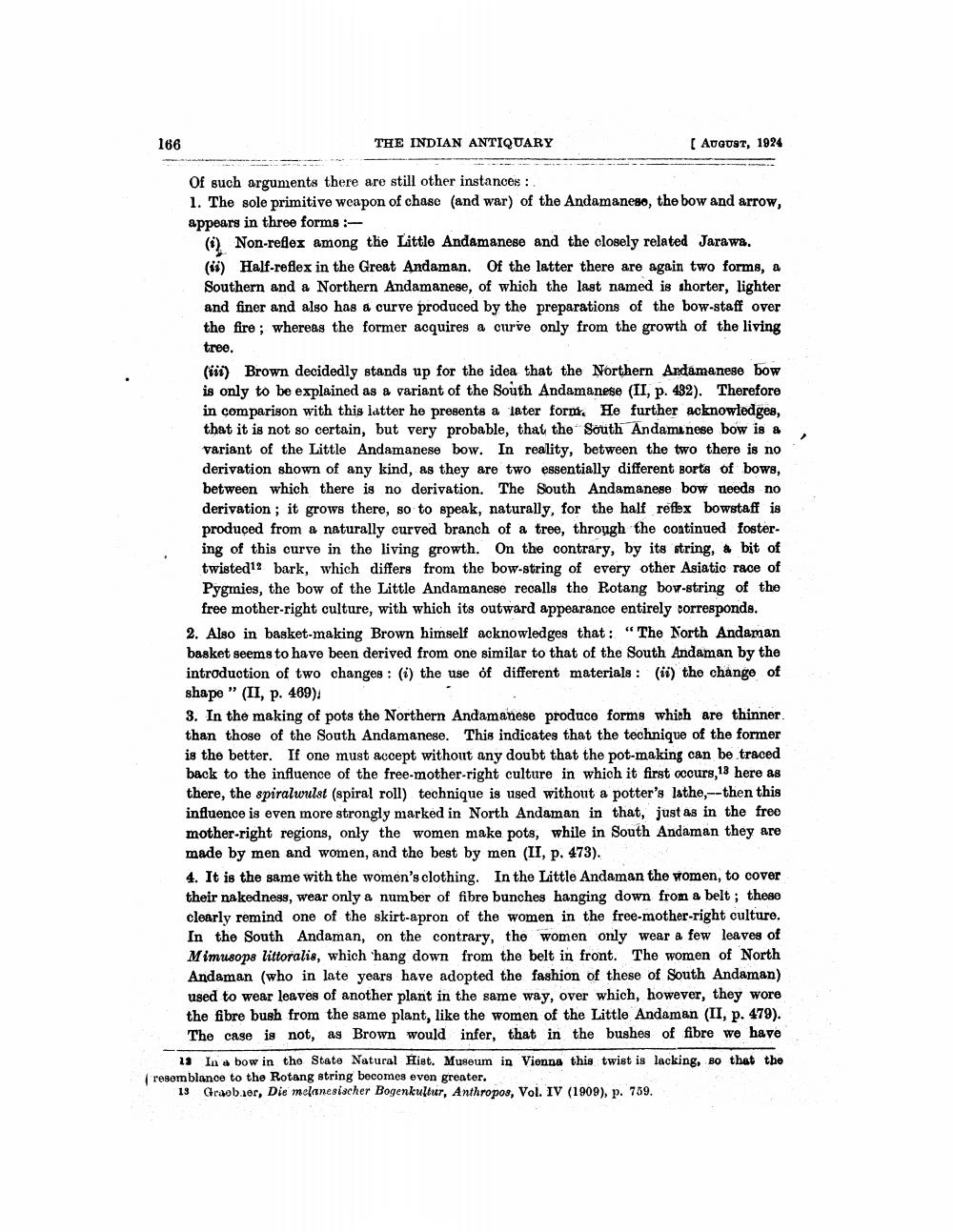________________
166
THE INDIAN ANTIQUARY
( August, 1924
Of such arguments there are still other instances : 1. The sole primitive weapon of chase (and war) of the Andamaneso, the bow and arrow, appears in three forms:
Non-reflex among the Little Andamanese and the closely related Jarawa. (1) Half-reflex in the Great Andaman. Of the latter there are again two forms, a Southern and a Northern Andamanese, of which the last named is shorter, lighter and finer and also has a curve produced by the preparations of the bow-staff over the fire ; whereas the former acquires a curve only from the growth of the living tree. (1) Brown decidedly stands up for the idea that the Northern Andamanese bow is only to be explained as a variant of the South Andamanese (II, p. 432). Therefore in comparison with this latter he presents a later form. He further acknowledges, that it is not so certain, but very probable, that the South Andamı nese bow is a variant of the Little Andamanese bow. In reality, between the two there is no derivation shown of any kind, as they are two essentially different sorts of bowe, between which there is no derivation. The South Andamanese bow teeds no derivation; it grows there, so to speak, naturally, for the half reflex bowstaff is produced from a naturally curved branch of a tree, through the continued fostering of this curve in the living growth. On the contrary, by its string, a bit of twisted12 bark, which differs from the bow-string of every other Asiatic race of Pygmies, the bow of the Little Andamanese recalls the Rotang bow-string of the
free mother-right culture, with which its outward appearance entirely corresponds. 2. Also in basket-making Brown himself acknowledges that: “The North Andaman basket seems to have been derived from one similar to that of the South Andaman by the introduction of two changes : (i) the use of different materials : (i) the change of shape" (II, p. 469) 3. In the making of pots the Northern Andamanese produce forms which are thinner. than those of the South Andamanese. This indicates that the technique of the former is the better. If one must accept without any doubt that the pot-making can be traced back to the influence of the free-mother-right culture in which it first occurs,13 here as there, the spiralwulst (spiral roll) technique is used without a potter's lathe,--then this influence is even more strongly marked in North Andaman in that, just as in the free mother-right regions, only the women make pots, while in South Andaman they are made by men and women, and the best by men (II, p. 473). 4. It is the same with the women's clothing. In the Little Andaman the women, to cover their nakedness, wear only a number of fibre bunches hanging down from a belt; these clearly remind one of the skirt-apron of the women in the free-mother-right culture. In the South Andaman, on the contrary, the women only wear a few leaves of Mimusop8 littoralis, which 'hang down from the belt in front. The women of North Andaman (who in late years have adopted the fashion of these of South Andaman) used to wear leaves of another plant in the same way, over which, however, they wore the fibre bush from the same plant, like the women of the Little Andaman (II, p. 479).
The case is not, as Brown would infer, that in the bushes of fibre we have
13 In a bow in the State Natural Hist. Museum in Vienna this twist is lacking, so that the resom blance to the Rotang string becomes even greater.
13 Graeber, Die melanesischer Bogenkultur, Anthropos, Vol. IV (1909), p. 759.




